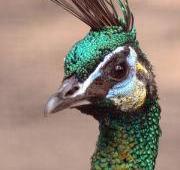 The peacock (also known as peafowl) is a medium sized bird most closely related to the pheasant. Unlike it's common pheasant cousin that inhabits areas of the Northern Hemisphere, the peacock is found in warmer climate of the Southern Hemisphere, with the peacock being most commonly found in India.
The peacock (also known as peafowl) is a medium sized bird most closely related to the pheasant. Unlike it's common pheasant cousin that inhabits areas of the Northern Hemisphere, the peacock is found in warmer climate of the Southern Hemisphere, with the peacock being most commonly found in India. There are three main types of peacock, the African Congo peacock, the Indian peacock and the Green peacock all of which are thought to have originated in Asia but are today found in Africa and parts of Australia. All of the three different species of peacock are knwon for their elaborate male peacocks and dull, brown female peacocks (in comparison to the males).
There are three main types of peacock, the African Congo peacock, the Indian peacock and the Green peacock all of which are thought to have originated in Asia but are today found in Africa and parts of Australia. All of the three different species of peacock are knwon for their elaborate male peacocks and dull, brown female peacocks (in comparison to the males).


Peacocks commonly get to about 20 years old, although some peacock individuals have been known to get to older ages particularly those peacock individuals that are in captivity. Generally, the peacock populations are not under great threat although the green peacock, is listed as being vulnerable to extinction mainly due to hunting and habitat loss.
Male peacocks are known as peacocks and female peacocks are known as peahens (in a similar way to chickens and pheasants). The male is peacock is generally about twice the size of the female peahen, and even larger when the male peacock is displaying his plumage (feathers). When the male peacock does not have his brightly coloured and very elaborate tail feathers on display, they drag behind him. This is known as a tail or a train.
During the mating season, the male peacock may mate with up to six different female peahens. The female peahen lays between 4 and 8 brown coloured eggs. The female peahen incubates her eggs by sitting on them, and the peacock chicks hatch after an incubation period of about a month. The female peacock, looks after and rears her peacock chicks on her own without any help from the male peacock.
Peacocks are most commonly found in deserts and dry savanna areas. Peacocks are also found in forests and dense foliage particularly during the breeding season when the female peacocks are trying to incubate their eggs and rear their chicks without any unwelcome predators spotting them.

